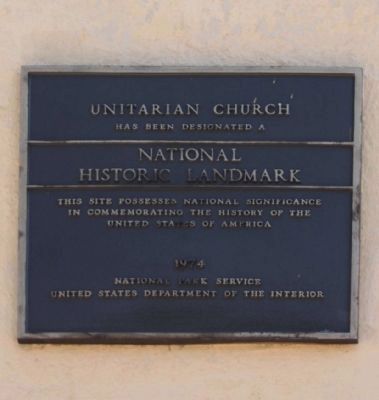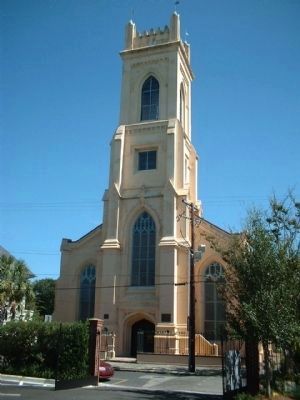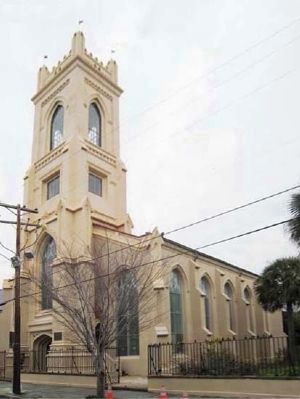Harleston Village in Charleston in Charleston County, South Carolina — The American South (South Atlantic)
Unitarian Church
Unitarian Church has been designated a National Historic Landmark. This site possesses national significance in commemorating the history of the United States of America.
Erected 1974 by National Park Service - United States Department of the Interior.
Topics and series. This historical marker is listed in this topic list: Churches & Religion. In addition, it is included in the National Historic Landmarks, and the Unitarian Universalism (UUism) series lists.
Location. 32° 46.713′ N, 79° 56.072′ W. Marker is in Charleston, South Carolina, in Charleston County. It is in Harleston Village. Marker is on Archdale Street. Touch for map. Marker is at or near this postal address: 6 Archdale Street, Charleston SC 29401, United States of America. Touch for directions.
Other nearby markers. At least 8 other markers are within walking distance of this marker. Philip Porcher House (within shouting distance of this marker); St. John's Church (within shouting distance of this marker); First Central Station in South Carolina (about 400 feet away, measured in a direct line); The Unitarian Church in Charleston (about 400 feet away); Fielding Home for Funerals (about 500 feet away); Jonathan Jasper Wright Law Office (about 700 feet away); Quaker Cemetery (about 700 feet away); Charleston Work House (about 700 feet away). Touch for a list and map of all markers in Charleston.
Regarding Unitarian Church. Begun in 1772, the church was gothicized by Francis D. Lee between 1852 and 1854. The building is a good
statement of the emotional mood of the mid-nineteenth century when the romantic and picturesque were
dominant not only in literature but also in building design. Of Gothic Revival design, the church has a crenellated four-story tower and lancet-arched windows. The main entrance is a Tudor arch, while the eighteen paned lancet arched main tower window has a crocketed hood mould. All windows in the west façade have hood moulds. The building is constructed of stuccoed brick and has false masonry buttresses. Lee designed the church’s interior to simulate that of the chapel of Henry VII at Westminster. The architect’s use of compound piers to “support” the ceiling and to divide the nave and the aisles is quite good and gives the arches an appearance of soaring to heights that they never reach physically. A great deal of Gothic tracery is used in balustrades and arches within the nave of the church. Listed in
the National Register November 7, 1973; Designated a National Historic
Landmark November 7, 1973.(South Carolina Department of Archives and History)
*** (added 1973 - - #73001696)
6 Archdale St. , Charleston
♦ Historic Significance: Architecture/Engineering
♦ Architect, builder, or engineer: Lee,Francis D.
♦ Architectural Style: Gothic Revival
♦ Area of Significance: Architecture
♦ Period of Significance: 1850-1874
Listed in the National Register November 7, 1973; Designated a National Historic Landmark November 7, 1973.
Credits. This page was last revised on February 16, 2023. It was originally submitted on October 11, 2011, by Mike Stroud of Bluffton, South Carolina. This page has been viewed 489 times since then and 12 times this year. Photos: 1, 2, 3. submitted on October 11, 2011, by Mike Stroud of Bluffton, South Carolina.


